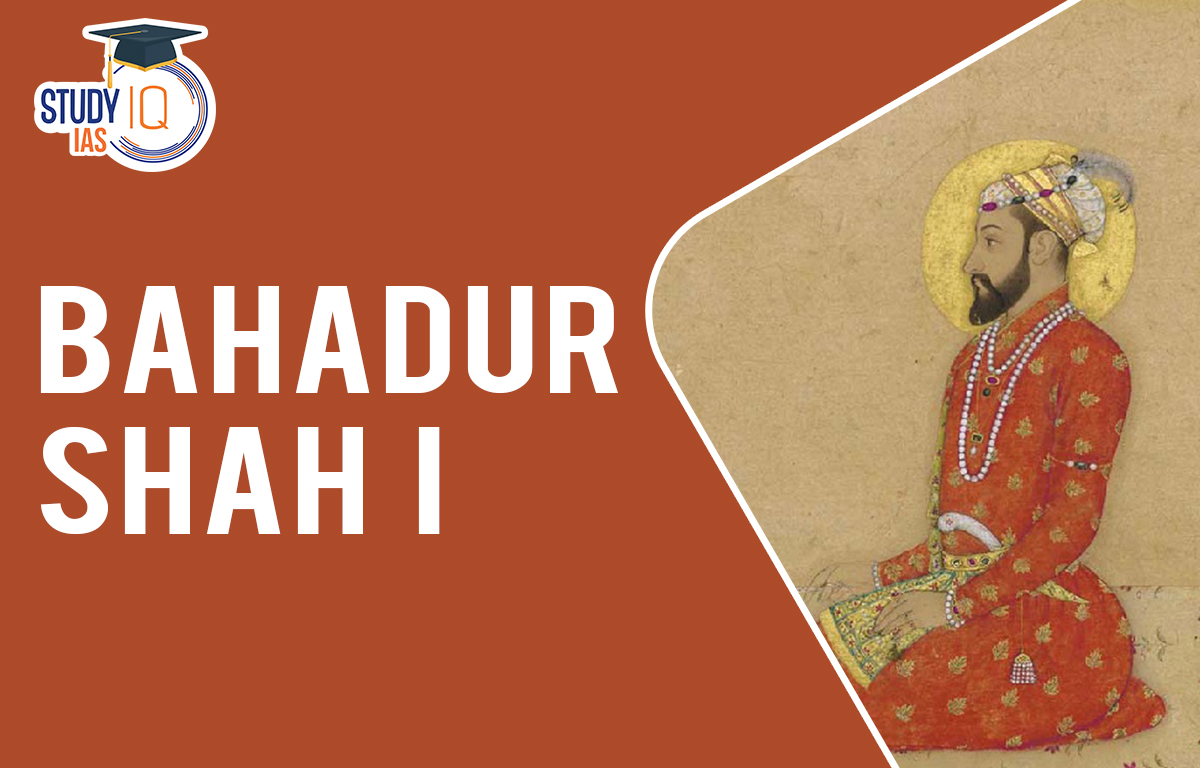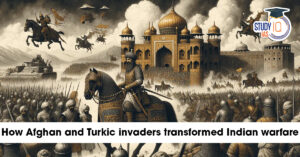Table of Contents
Bahadur Shah I, also known as Muhammad Muazzam and Shah Alam I, was the seventh Mughal emperor of India, ruling from 1707 to 1712. He was the second son of the great Aurangzeb and ascended the throne after a fierce war of succession following his father’s death. Though his reign was short-lived, Bahadur Shah I played a crucial role in stabilizing the empire during turbulent times and easing some of the rigid policies of his predecessor.
Bahadur Shah I
Read all the details about Bahadur Shah I. The eighth Mughal emperor of India, Bahadur Shah I, often referred to as Muhammad Mu’azzam and Shah Alam, ruled from 1707 until 1712. While still a child, he devised a plan to overthrow his father, the sixth Mughal emperor, and ascend to the throne. Muazzam assumed the throne and the title of Bahadur Shah at the age of 63. To prepare for the UPSC Civil Service Exam, this page will provide you with information on Bahadur Shah I (1707–1712).
Read about: Decline of Mughal Empire
Bahadur Shah I Early Life and Family
On October 14, 1643, at Burhanpur, Mu’azzam, the third child of Aurangzeb, the sixth Mughal emperor, and his wife Nawab Bai, Bahadur Shah I was born. During Shah Jahan’s rule from 1653 until 1659, Mu’azzam served as the vizier of Lahore. Shaista Khan was replaced as Deccan administrator by Mu’azzam in 1663.
The Mughal Deccan capital Aurangabad was invaded by Shivaji, although Mu’azzam did little to stop him. A furious Aurangzeb sent Raja Jai Singh, his most capable commander, to battle Shivaji, and it was here that the historic Treaty of Purandar was written. Mu’azzam was given command of the Deccan after Raja Jai Singh I beat Shivaji at Purandar in May 1667. He received assistance from Maharaja Jaswant Singh.
To overthrow Aurangzeb and establish himself as the new Mughal emperor, Mu’azzam staged an uprising in 1670. When Aurangzeb used scorched earth methods to put down Rajput uprisings in 1680, Mu’azzam came dangerously close to a second uprising. Aurangzeb once more gently rebuked Mu’azzam while keeping a closer eye on him.
Read about: Later Mughal
Bahadur Shah, I Reign
Without selecting a crown prince, Aurangzeb passed away in 1707, leaving Mu’azzam in charge of Kabul and his younger half-brothers, Muhammad Kam Bakhsh and Muhammad Azam Shah, in charge of the Deccan and Gujarat, respectively. The three sons started minting coins in Kam Bakhsh’s name because they were all intent on claiming the throne.
Azam was defeated by Mu’azzam in the Battle of Jajau in June 1707, and he had intended to march on Agra and proclaim himself the new ruler. Azam and his son Ali Tabar died in the conflict. Muazzam became king and was given the title Bahadur Shah I when he was 63 years old. He treated the nobles with generosity, giving them their favorite estates and elevating them.
The state’s finances have suffered as a result. Legend has it that the wazir Zulfiqar Khan possessed the real power. He was tolerant of Hindus, but he never got rid of the jizya tax. During his reign, the independence of Marwar and Mewar was acknowledged. However, the settlement was unable to restore these countries to their prior position as fully committed allies of the Mughal cause.
He also had a half-hearted plan for rapprochement with the Marathas. Shahu, whom he released, wasn’t regarded by him as the rightful Maratha ruler. He could not fully appease them because he only gave the Deccan sardeshmukhi to the Maratha and not the Chauth. As a result, the Marathas continued to engage in combat with the Mughals and one another.
The Marathas, who had posed the greatest threat to Mughal sovereignty under Aurangzeb, and who had held Shahu, Shivaji’s grandson, as a prisoner at his court, were the group that Bahadur Shah I tried to make peace with. By installing Shahu as Raja of Satara in the center of Maratha territory, Bahadur Shah I hoped to placate the Marathas.
Shahu was a nice courtier who seemed to do well by the Great Mughal, but the clever Chitpavan Brahman Balaji Vishvanath, whose son Baji Rao ascended to become the strongest danger to Mughal rule, nominated him to be Peshwa of Pune. He received assistance from Bundella Chief Chattrasal and Jat Chief Charuman in his conflict with the Sikhs.
The eleventh Sikh Guru, Guru Gobind Singh, received a high mansab. However, he had to contend with Banda Bahadur’s uprising, and it was during this conflict that he passed away (in 1712 CE). He was known as “Shah-i-Bekhabar” by Mughal historians like Khafi Khan. Following him was his son Jahandar Shah, whose rule was considerably less prosperous than that of his father.
However, the Mughal rule continued. Instead, several organizations began to use the Mughal Empire for their purposes, leaving Bahadur Shah’s successors as nothing more than pawns in the political game of eighteenth-century India.
Bahadur Shah I and Sikh Rebellion
Shah Bahadur After learning about the uprising led by Banda Bahadur in Punjab just a year after Guru Gobind Singh’s passing, I left the Deccan for the north. Slowly, the Sikhs made their way to Delhi, where they joined the Hissar sarkar and started preparing for a military campaign.
They attacked Samana in November 1709 and, while ravaging the town, defeated the faujdar in the Battle of Samana. The Mughals were ejected from Jalandhar and Amritsar by the Sikhs. They urged the Faujdar of Jalandhar, Shamas Khan, to adopt reforms and deliver the funds.
Shamas pretended to be in submission before attacking them. He made an appeal to Muslims under the garb of religion and declared war on the Sikhs. Sikhs took use of their newfound power to remove Mughal officials and install Sikhs in their places. Banda established a mint in Lohgarh, the location of his first capital. He abolished the Zamindari Mugal system and gave growers the right to own their own land.
Bahadur Shah I Coin Age
Although he produced coins in gold, silver, and copper, his forebears’ coinage was still widely utilized in trade and to pay government employees. Re-minted copper coins bearing Aurangzeb’s name were issued during his rule. Danishmand Khan, a poet, submitted two lines for the coins but they were disregarded, therefore they did not carry his name in a couplet like the previous Mughal Emperors did.
Bahadur Shah, I UPSC
The five years of Bahadur Shah I’s tenure, from 1712 to 1713, were spent trying to topple his father’s strict laws. Although he was unable to eradicate Jizya, he did promote music, allowing people to once again hear the sounds. He made an effort to reach an understanding with the Marathas and Sikhs. He passed away in 1712 while in charge of the Shalimar Gardens renovations in Lahore. His son Jahandar Shah pursued after him. Complete information on Bahadur Shah I for UPSC Exam Preparation is provided in this article.
Read about: Anglo-Maratha War


 Birsa Munda Birth Anniversary 2025: Life...
Birsa Munda Birth Anniversary 2025: Life...
 Military Innovations of Afghans and Turk...
Military Innovations of Afghans and Turk...
 Self-Respect Movement, History, Objectiv...
Self-Respect Movement, History, Objectiv...

























